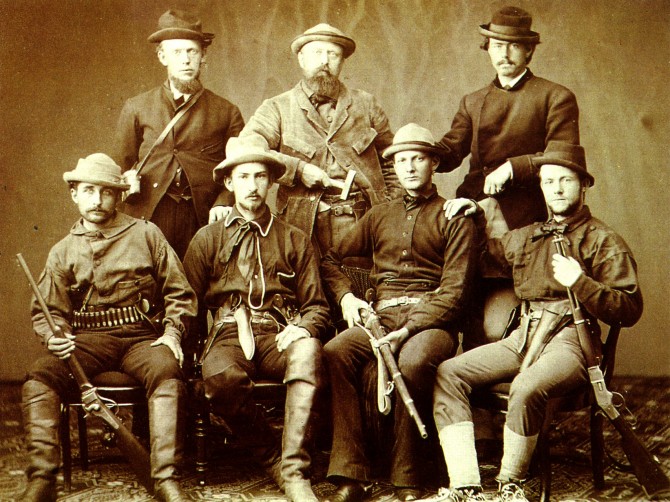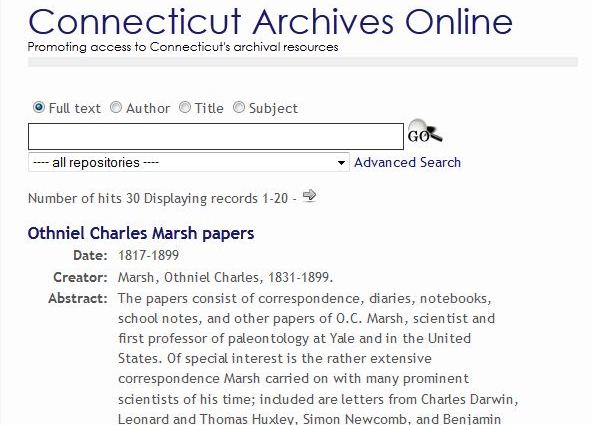by Brian Stevens – Connecticut Archives Online, Western Connecticut State University
The Who and What:
You could probably guess what archives might be, but think you have never seen one, or have never used one. The truth is most of us have probably used archives and don’t even know it. For example, Ancestry.com uses archival material to provide users with information that they get from the National Archives and Records Administration. People who do research on Ancestry.com use archives every time they log into the site!

An example of a Finding Aid’s Table of Contents – Yale University Library, Manuscripts and Archives, Guide to the Othniel Charles Marsh Papers
According to the Society of American Archivists, things kept in archives are “materials created or received by a person, family, or organization, public or private, in the conduct of their affairs and preserved because of the enduring value contained in the information they contain or as evidence of the functions and responsibilities of their creator…” An archive is the place where archival materials are kept and the archivist is the person in charge of preserving and providing access to those materials. An archivist usually has received academic training with certification, or has a library science degree.
A key element of this definition is that “[materials are] preserved because of the enduring value contained in the information they contain.” Enduring value is a subjective judgment, but someone has to determine whether one person’s materials have enduring value, and whether someone else’s do not. These materials can be letters, photographs, audio recordings, art, email, knick-knacks, etc. Usually, the materials are not published (In a majority of cases, archival materials are primary source materials).
In archives, the assembled materials are referred to as collections. An archive, also called a repository, usually has many collections.
Archives will create what is called a finding aid for their individual collections. Finding aids will have notes about the nature of the collection and what the collection contains, and also an inventory (known also as a box and folder list) of the contents of a particular collection. When patrons go to archives they ask for a certain box from a collection. That information they may get from reviewing a finding aid.
Where
Archives, unlike libraries, do not collect every subject. Archives will generally have a mission statement or collections policy that dictates what subject areas they collect. So where archives are can sometimes–though not always–tell you about what they collect.
Archives exist in certain places for a number of reasons. Archives collect materials that support or maintain the institutional memory of their parent organization or to document aspects of their operation; they may do this out of legal obligation or by the dictates of the institution. Archives collect to support research missions which can vary from very general – like US History – to very specific – 19th Century gunmaking. They may collect a particular time period or materials relating to specific person, place, or thing. In this way archives are similar to museums.
There is significant overlap between the mission of museums and archives and to make things even more confusing – many museums have archives. Essentially, the difference is this: museums generally specialize in items and exhibition of those items, and archives generally specialize in collections (much of which is textually based) with particular regard to whom those collections belonged and why the materials were assembled. Museums are generally exhibition based; archives are generally research based. There is also an implication in archives that material is being collected by the archives for its research value while museums may lean toward monetary or aesthetic value.
Because archives’ collections are almost by definition “one of a kind,” archives are located in secure facilities that require appointments and for patrons to register to see and use the materials in the archive.
When and Why
You go to archives when there is a need to research primary source materials that relate to a person, family, or organization, public or private. Why archives are critical to society is that they represent, as much as is possible, an impartial documentation of events. These materials provide direct evidence of who and what we are and where we come from. For institutions and libraries that contain archives, the archival collections may represent the only materials that make that institution’s or library’s holdings unique.
How to use Archives
If you are doing research on a past Governor of Connecticut, for example, and wanted archival materials relating to that person, a good place to start is not in archives but in secondary sources. Look at bibliographies of people that have written about them. In those sources, you may find an archival collection was cited. The citation will tell you where that author found the information. You might find information on where that Governor went to college, and places they lived. Many persons, or family members, donate papers to their alma mater or to the historical society where they lived. If you find material cited in an archive, you will likely need to contact the institution to make an appointment to view the materials. You may also need to explain precisely what you are researching. That being said, archivists want you to use their materials and will try to accommodate research at a range of levels.
For topics about which nothing has been published, look to persons, places, things, or events around them. You might have to travel to a place a person once lived or call the local historical societies or libraries for information.
However, with the use of a computer, researching the famous or the obscure is infinitely easier. In Connecticut, we are fortunate to have the cooperation of many archives around the state who have pooled their collections’ finding aids into the Connecticut Archives Online or the CAO. By entering a search term in the search box, one can search across hundreds of archival collections in the state. Many archives have their own in-house searches but because of the nature of archives collections, it is sometimes preferable to researchers to be able to search across a wide range of collections, which is the service the CAO provides. Brian Kennison and Brian Stevens developed the CAO at Western Connecticut State University with the cooperation of the other State Universities and Connecticut State Library.
If you have questions about using the CAO or would like to have your collections represented there, please contact Brian Stevens at stevensb@wcsu.edu for details. You may also consult the CAO’s “about” pages at: http://library.wcsu.edu/cao/about.
The goal of every archivist is to preserve and provide access to materials of enduring research value. In Connecticut, we have amazing materials in our archives that are full of stories yet to be explored by researchers. Additionally, Connecticut has a great deal of archival material that has yet to see that light of day; we archivists are here as a resource to help and advise museums, historical societies, and libraries who have these materials but are unsure about how to maintain them or how to let people know they exist. If this last statement applies to you, please feel free to contact the Connecticut Humanities, the Connecticut League of History Organizations, or the Connecticut Archives Online.










